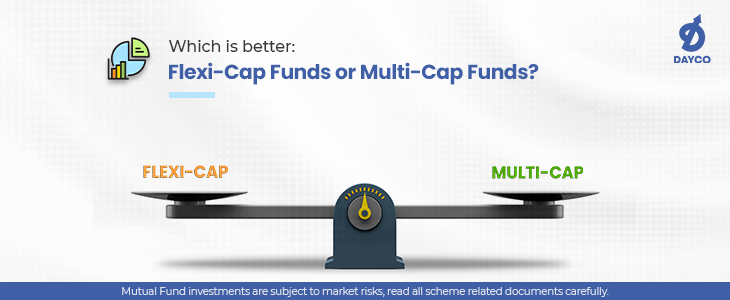With an abundance of investment options available, it’s essential to understand the nuances of different strategies and select the approach that aligns with your financial goals. Both Flexi Cap and Multi-Cap funds offer distinct advantages. In this article, we unravel the mysteries surrounding these investment styles, dissect their characteristics, and provide insights to empower you in making wise choices. So, let’s dive in and discover the perfect investment strategy that will lead you toward financial success.
When it comes to investment decisions, you should tailor them according to your own risk appetite. Your unique financial goals play a crucial role in determining the path you should take. Risk profiling is a valuable tool that can help assess your risk tolerance and ability to take risks in pursuit of your financial objectives. Factors such as your age, number of dependents, liabilities, loss-bearing capacity, and time horizon for achieving your goals all contribute to your risk-taking ability. Understanding your risk profile is an essential component of making informed investment decisions that align with your individual circumstances.
In the realm of finance, there is no definitive notion of a “good,” “better,” or “best” equity fund category for investment. The suitability of an investment option depends on your specific risk profile and unique circumstances. Mutual funds have gained popularity among investors as they aid in long-term wealth creation and provide a means of combating the impact of inflation over time. As a result, mutual funds have become an integral part of many investors’ portfolios.
However, as per SEBI guidelines on the Categorization and Rationalization of Equity schemes in October 2017, prior to November 2020, there was no existence of the Flexi Cap category. Only the Multi Cap category was there with a condition to invest at least 65% of their assets in equities without any minimum or maximum investment limit in any Equity categories like Large Cap, Mid Cap, or Small Cap. Fund managers were allowed to allocate the scheme’s money according to their choice of category with a minimum Equity exposure of 65%.
Considering the recommendations of the Mutual Fund Advisory Committee and also to offer more flexibility to Mutual Fund investors, SEBI has introduced a new category named “Flexi Cap Fund” under the category of Equity fund vide SEBI Circular dated 6th Nov 2020.
As per new guidelines issued by SEBI, Flexi Cap Funds have to invest a minimum of 65% of total assets in Equity and Equity related instruments, and on the contrary, multi-cap funds have to invest a minimum of 75% of total assets in Equity and Equity related schemes with a minimum investment cap of 25% of total assets in Large cap, Mid Cap and Small Cap respectively.
Both Flexi Cap and Multi Cap funds aim to provide growth in the long term. Unlike Multi Cap funds, the Fund Managers of the Flexi cap funds are free to choose the ratio between the Large Cap, Mid Cap, and Small Cap and enjoy much more flexibility during the turmoil time of the Equity market. The Fund Managers of Flexi Cap funds could increase or decrease their allocation in a particular segment based on the performance and market condition at any given time. Whereas Multi Cap funds can invest more in Equities and Equity related instruments of their total asset with a cap of a minimum of 25% in Large Cap, Mid Cap, and Small Cap.
Important points to be noted while making investment decisions either in flexi-cap or multi-cap funds
| Flexi Cap Fund | Multi Cap Fund |
| Flexi Cap funds are free to invest in any market cap without any minimum or maximum limit. It may invest 100% in Large Cap or 100% in Mid Cap, or 100% in Small Cap. The minimum Equity exposure of Flexi Cap should be 65% of the total asset. | Multi Cap funds require to have a minimum of 25% allocation of their portfolio in Large Cap, Mid Cap, and in Small Cap. Thus the minimum Equity exposure of Multi Cap should be 75% of the total asset. |
| Enjoy the freedom to invest across Large, Mid, and Small Cap. Flexi Cap funds offer exposure to a wide variety of equity securities covering all Industries irrespective of Market Capitalization and sectors. A broadly diversified portfolio helps the Flexi Cap funds a lot of flexibility in managing the volatility of the market. | Fund Managers have limited options during the rebalancing of the Portfolios due to Market Cap limitations as specified by SEBI. Multi Cap Funds are more aggressive and volatile in comparison to Flexi Cap funds. |
| Flexi Cap funds are ideal for investors seeking for Long term market appreciation without taking much risk. To get the best return from a Flexi Cap Fund, an investor’s investment time horizon should ideally be 5 to 7 years. | Multi Cap funds are ideal for investors with more Risk tolerance as the Fund Managers have to invest a minimum of 25% in each of Large, Mid, and Small Cap. To derive the best from a Multi Cap fund, an investor’s investment time should ideally be 5 to 7 years. |
The Conclusion
In conclusion, the choice between Flexi Cap and Multi-Cap funds should be made with careful consideration of your risk profile and financial goals. Each approach offers its own set of advantages, and understanding your risk tolerance and investment horizon is key to making an informed decision.
If you have a question, share it in the comments below or DM us or call us – +91 9051052222. We’ll be happy to answer it.
~Suman Dan
















